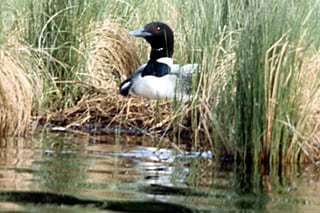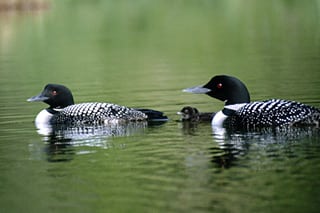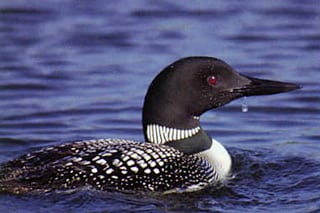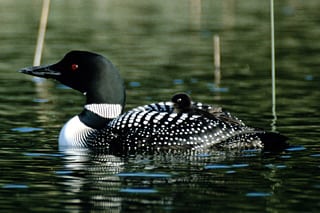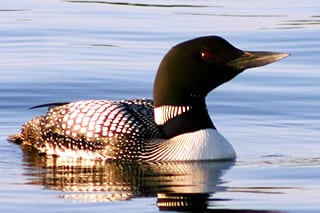Loon Watcher Program
Loon Watchers
July 11, 2006
Mary LaPorte
I never really paid too much attention to birds in the past. They perch on my poplar trees every day and there is one who has taken residence under my deck. Driving around town you’ll see loon planters, chimes, paintings, and you can hear them if you listen. But I never really listened… that is until I met Pam Perry.
Minnesotans are in love with loons, so I went to Pam’s office at the DNR building in Brainerd, Minnesota to interview her about them. Pam works in the Nongame Wild life Program for the DNR and has an extensive background in wildlife and endangered species. She has a Bachelor of Science degree in wildlife management and a Master of Science degree in wildlife ecology. Pam is also well known for the Loon Watcher Program which she runs.
When I sat down at her desk for the interview my foot hit something, I casually looked down and noticed I had bumped a stuffed bird perched on a log. To the right was a bookshelf stocked full with magazines and publications on loons and other non-game species. On top of that sat a tan and olive speckled egg, which later I learned was a replica of a loon egg.
I started the interview by asking her where to find loons. Pam explained that MN has the largest Common Loon population in the lower 48 states, but Canada and Alaska have more, including 3 other species of loons. There are about 12,000 adult Common Loons in Minnesota and it makes sense that it’s our state bird. They are even on the Minnesota quarter. Loons are part of the atmosphere and they remind people of the lake and memories of vacationing “up north”.
How do they get that eerie call? There are 4 basic calls of the Common Loon. One is the Hoot, which is used for family socializing. This is how they speak to their chicks, mates and other loons. The next one is the Wail. This is the one that most people know the best. It is heard in the evening and echoes for miles. This is to locate and keep in touch with other loons in nearby lakes. Third is the Tremolo. It sounds like crazy laughter and is from fear or irritation. You will hear this when you make a loon upset or it feels threatened by another animal.. The last sound is the Yodel. This is from a male trying to stake and defend their territory. They usually make this call when the eggs are incubating and they don’t want you too close.
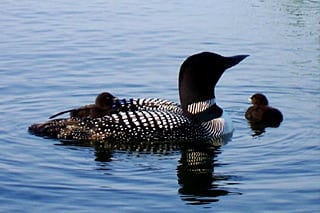
How can we protect the loons and chicks? Understand and learn about loons. In June the loons are nesting and the adults sit on the nest and take turns while they are incubating. This goes on for about 30 days. If you are boating around and see a nest and approach it you may be the 10th person to have tried that in an hour. The loon can get irritated and may get off the nest until you pass. If this happens any number of things can eat the eggs. It is critical to keep your distance. If you want to take a peak get out your binoculars and watch from afar. To find out where the nest is look for one loon in the water, keep watching and you’ll eventually see the loon return to shore, then another one will come out. They are trading spots on the nest. Finding out where the nest is can help you protect them. If you see a boater near the nest or fishing too close, go out and tell them to move – you will be helping in more ways than you’ll ever know.
Other threats are lead tackle, mercury, phosphorus that causes algae blooms, fishing line and plastic trash. Once the chicks are hatched jet skis and boats can be an issue too. Baby loons are not great swimmers at first and can’t dip and turn like the adults. Pam said that when baby loons try to dive into the water they are like bobbers – they pop back up right away. Be aware when you are on the water and watch out for them,
One of the most interesting things about loons is that in the fall they go from fresh water to salt water. They migrate to the Atlantic coast or the Gulf of Mexico alone, not in the traditional V pattern that many other waterbirds use. Their winter plumage is grey and stays that way until spring, when the distinctive black and white pattern returns. They also loose the beautiful calls in the non-breeding season. In the spring the loons will find their way back to the same lake they were at before – and some even mate with the same partner. So if you see the same nest year after year, you most likely have a permanent neighbor. They can live to be up to 30 years old, so we should get used to them and help protect them – they are an asset to our lakes.
Because loons nest on shore it is important to keep your cabin’s landscape near the water as natural as possible. There are many things you can do to your bank or waterfront, like retaining walls or large rocks lining the entire embankment. This is very harmful for the birds and although it looks nice, it really isn’t necessary. Keeping your shoreline natural will benefit the loons and you will hopefully gain a new neighbor and be able to hear and see the loons right from your windows.
Another interesting fact is that they have solid bones, unlike most other birds, who have hollow bones. This helps them dive deeper and explains why they go a long distance before taking off into the air. They also have blood red eyes that aid them in seeing under water (MN DNR).
So what can you do to help? Pam runs a program called the Loon Watchers. This is a group of about 300 + people in the state of Minnesota who are dedicated to finding where the nests are and protecting them. They cover about 337 lakes in 29 counties. Last year the Loon Watchers reported 1,583 adults and 425 chicks. They also try to make the lake environment friendly for the loons. The hope is to have every lake in the state covered by the Loon Watchers.
Anyone who is willing can join this program and be a Loon Watcher on their lake. Larger lakes can have multiple loon watchers so call Pam and see if there is an opening. You never know, you may be the first and only Loon Watcher for your lake.
Another way to help is to make a tax-deductible donation on your Minnesota income and property tax forms. These donations help even if you don’t have the time to participate in the programs.
The weekend after my interview with Pam I was out on a local lake with my family and this time I was looking for loons. I saw many birds and creatures that were always there, I just never took the time to see them. It is fascinating to realize there is a whole world out there that I never really paid attention to.
Nearly everyone who visits the Brainerd Lakes Area knows and loves the loons. It’s part of the experience and atmosphere of being at the lake. Don’t forget to watch out for, and protect the loons – and remember to listen!
Mary LaPorte
Pam Perry, Regional Nongame Specialist
DNR Headquarters
1601 Minnesota Drive
Brainerd, MN 56401
218/828-2228
pam.perry@dnr.state.mn.us

